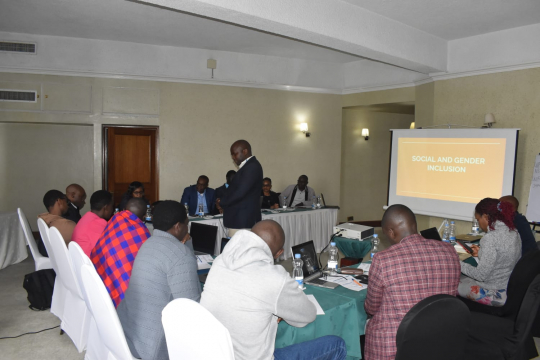Women are disproportionately affected by the water crisis, as they are often responsible for collecting water. This takes time away from work, school, and caring for family. Lack of water and sanitation locks women in a cycle of poverty. Thus, there is a need for sustainable solutions.
Environment for Development, Kenya hosted a workshop on July 19, 2024, at the Nairobi Safari Club Hotel to build stakeholders' capacity on Socially and gender-inclusive payment for ecosystem services in the water sector.
Worldwide, 2.2 billion people lack access to safe drinking water. In Sub-Saharan Africa, the number is nearly 400 million, and 22 million in Kenya. By 2025, 50% of the world’s population is projected to live in water-stressed areas due to climate change, with low-income families bearing the greatest burden of this crisis.
Insights from Costa Rica’s PES program
A solution to the water crisis is Payment for Ecosystem Services (PES). PES is the transfer of a positive incentive to the environmental service providers conditional to the provision of an environmental service. A successful case study in Costa Rica highlights the PES program, developed through a consultative process involving diverse stakeholders and organizations. This program provides private landowners with cash transfers and offers them five- or ten-year contracts to participate in forest protection, reforestation, sustainable forest management, and agroforestry. Additionally, the program emphasizes gender and social inclusion, focusing on local families, indigenous communities, and family associations.
According to Richard Mulwa, Director of EfD Kenya, specific criteria must be met for a project to qualify for Payment for Ecosystem Services (PES). First, the transaction must be voluntary, with both the buyer and seller participating willingly and without coercion. Second, the ecosystem service must be clearly defined such as to offer clean water. Third, there must be a clear buyer or group of buyers willing to pay for this service. Fourth, there must be an identifiable service provider. Lastly, the provider must demonstrate the ability to deliver the ecosystem service.
Success stories encourage best water management practices
In Kenya, there are various water management practices. They include rainwater harvesting, use of borehole water, monitoring household water consumption, and managing and distributing piped water through utility companies. Conservation efforts, such as planting fodder around water pans and trees in the Mau catchment areas, and fencing spring areas are also management practices being implemented. However, challenges persist, such as high volumes of unaccounted-for non-revenue water, high water tariffs, breakage of water supply pipes, delays in maintenance and reconnection of water services to citizens, vandalism of water infrastructure, inadequate water supply, and insufficient monitoring of tree planting initiatives to ensure growth.
Sharing success stories of water management initiatives within the community promotes the adoption of best practices. In Sasumua, over 80% of the planted trees have survived, and the project has also shortened the distance women must travel to fetch water. Additionally, the Narumolo irrigation project has enhanced the livelihoods of residents.
Diverse stakeholders need to cooperate
Key stakeholders in water management are the consumers, water resource user associations, community forest associations, water vendors, and service providers like Nairobi Water. Other important participants include Water Works Development Agencies, county governments, and the Water Resources Authority. Additionally, the Kenya Forest Service, the National Water Harvesting Authority, the Kenya Water Tower Agency, the Kenya Wildlife Service, the Ministry of Water and Sanitation, the Ministry of Agriculture and Livestock Development, community-based associations, farmer associations, financiers, NGOs, and donors are crucial stakeholders in water management practices.
Rewards are given for maintaining water resources
There exist few projects that offer incentives to those managing water resources. For example, the Tana River Basin project offers payments to upstream communities for watershed conservation activities. The Kasigau Corridor REDD+ Project provides carbon credits as financial incentives to reduce emissions from deforestation and forest degradation. The Mau Forest Complex Initiative promotes alternative livelihoods to lessen the pressure on forest resources and the Lake Naivasha watershed project provides financial incentives to upstream farmers to adopt soil and water conservation practices.
Fairness and transparency are important factors
Among the major challenges for PES programs is the lack of clear and transparent incentive structures. Participants need to understand the benefits they will receive and how their conservation efforts contribute to the overall goal. To ensure fair distribution of PES payments within communities, participants suggested developing revenue-sharing mechanisms, to anchor PES in law, raise awareness, and build community capacity for program success.
To ensure that women and marginalized groups are fully included in PES programs, there is a need to apply the constitutional gender rule in all participatory efforts and actively involve the marginalized in decision-making, planning, and governance.
By Jane Maina
